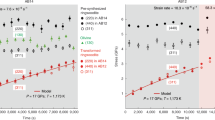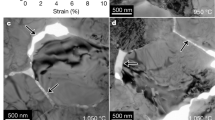Abstract
The dynamics of the Earth's deep interior are controlled to a large extent by rheological properties1,2. Until recently, however, experimental studies on the rheological properties of materials thought to be present in the Earth's deep interior have been limited to relatively low pressures. Most previous estimates of rheology have therefore been based on either large extrapolations of low-pressure experimental data3,4 or inferences from geodynamical observations5,6,7. Such studies have provided only weak constraints on the complicated rheological structure expected in the transition zone of the Earth's mantle (between 410 and 660 km depth) where a series of phase transformations occur in silicate minerals8. Here we report the results of a direct experimental study of deformation, under transition-zone conditions, of the spinel phase of (Mg,Fe)2SiO4 (ringwoodite; thought to be present in the Earth's transition zone). Relatively coarse-grained samples show evidence of dislocation creep with dislocation structures similar to those observed in oxide and germanate spinels9,10, which have significantly higher creep strengths than olivine10,11. In contrast, a fine-grained sample shows evidence for grain-size-sensitive creep. These observations suggest that a ringwoodite-rich layer of the transition zone is likely to have a higher viscosity than the olivine-rich upper mantle3, whereas a subducting slab in the deep transition zone may lose its strength if significant grain-size reduction occurs12,13,14.
This is a preview of subscription content, access via your institution
Access options
Subscribe to this journal
Receive 51 print issues and online access
$199.00 per year
only $3.90 per issue
Buy this article
- Purchase on Springer Link
- Instant access to full article PDF
Prices may be subject to local taxes which are calculated during checkout


Similar content being viewed by others
References
Forte, A. M. & Woodward, R. L. in Earth's Deep Interior (ed. Crossley, D. J.) 337–404 (Overseas Publishers Assoc./Gordon & Breach, Amsterdam, 1997).
Bunge, H-P., Richards, M. A. & Baumgardner, J. R. The effect of viscosity stratification on mantle convection. Nature 379, 436–438 (1996).
Karato, S. Plasticity-crystal structure systematics in dense oxides and its implications for the creep strength of the Earth's deep interior: A preliminary result. Phys. Earth Planet. Inter. 55, 234–240 (1989).
Borch, R. S. & Green, H. W. I Dependence of creep in olivine on homologous temperature and its implication for flow in the mantle. Nature 330, 345–348 (1987).
Peltier, W. R. in Mantle Convection (ed. Peltier, W. R.) 389–478 (Gordon & Breach, New York, 1989).
Mitrovica, J. X. & Forte, A. M. Radial profile of mantle viscosity: Results from the joint inversion of convection and postglacial rebound observables. J. Geophys. Res. 102, 2751–2769 (1997).
Kido, M. & Cadek, O. Inferences of viscosity from the oceanic geoid: Indication of a low viscosity zone below the 660-km discontinuity. Earth Planet. Sci. Lett. 151, 125–137 (1997).
Ringwood, A. E. Phase transformations and their bearing on the constitution and dynamics of the mantle. Geochim. Cosmochim. Acta 55, 2083–2110 (1991).
Duclos, R., Doukhan, N. & Escaig, B. High temperature creep behaviour of nearly stoichiometric alumina spinel. J. Mater. Sci. 13, 1740–1748 (1978).
Dupas-Bruzek, C., Green, H. W. II., Doukhan, N., Doukhan, J-C. & Tingle, T. N. The rheology of olivine and spinel magnesium germanate (Mg2GeO4): TEM study of the defect microstructures. Phys. Chem. Miner. (in the press).
Lawlis, J. R., Zhao, Y. & Karato, S. High temperature creep of nickel germanate spinel. Eos 79, S331 (1998).
Vaughan, P. J. & Coe, R. S. Creep mechanism in Mg2GeO4: effects of a phase transition. J. Geophys. Res. 86, 389–404 (1981).
Rubie, D. C. The olivine → spinel transformation and the rheology of subducting lithosphere. Nature 308, 505–508 (1984).
Riedel, M. R. & Karato, S. Grain-size evolution is subducted oceanic lithosphere associated with the olivine-spinel transformation and its effects on rheology. Earth Planet. Sci. Lett. 148, 27–44 (1997).
van der Hilst, R. D., Engdahl, E. R., Spakman, W. & Nolet, G. Evidence for deep mantle circulation from global tomography. Nature 353, 37–43 (1991).
Fukao, Y., Obayashi, M., Inoue, H. & Nenbai, M. Subducting slabs stagnant in the mantle transition zone. J. Geophys. Res. 97, 4809–4822 (1992).
Zhou, H. Ahigh-resolution P wave model for the top 1200 km of the mantle. J. Geophys. Res. 101, 27791–27810 (1996).
Machetel, P. & Weber, P. Intermittently layered convection in a model mantle with an endothermic phase-change at 670 km. Nature 350, 55–57 (1991).
Peltier, W. R. & Solheim, L. P. Mantle phase-transitions and layered chaotic convection. Geophys. Res. Lett. 19, 321–324 (1992).
Honda, S., Yuen, D. A., Balachandar, S. & Reuteler, D. 3-dimensional instabilities of mantle convection with multiple phase-transitions. Science 259, 1308–1311 (1993).
Tackley, P. J., Stevenson, D. J., Glatzmaier, G. A. & Schubert, G. Effects of an endothermic phase-transition at 670 km depth in a spherical model of mantle convection in the Earth's mantle. Nature 361, 699–704 (1993).
Dupas, C., Doukhan, N., Doukhan, J-C., Green, H. W. I & Young, T. E. Analytical electron microscopy of a synthetic peridotite experimentally deformed in the β olivine stability field. J. Geophys. Res. 99, 15821–15832 (1994).
Dupas-Bruzek, C., Sharp, T. G., Rubie, D. C. & Durham, W. B. Mechanisms of transformation and deformation in Mg1.8Fe0.2SiO4olivine and wadsleyite under non-hydrostatic stress. Phys. Earth Planet. Inter. 108, 33–48 (1998).
Karato, S. & Rubie, D. C. Toward an experimental study of deep mantle rheology: A new multianvil sample assembly for deformation studies under high pressures and temperatures. J. Geophys. Res. 102, 20111–20122 (1997).
Ohtani, E. & Kumazawa, M. Melting of forsterite Mg2SiO4up to 15 GPa. Phys. Earth Planet. Inter. 27, 32–38 (1981).
Katsura, T. & Ito, E. The system Mg2SiO4-Fe2SiO4at high pressure and temperature: precise determination of stabilities of olivine, modified spinel and spinel. J. Geophys. Res. 94, 15663–15670 (1989).
Vaughan, P. J. & Kohlstedt, D. L. Cation stacking faults in magnesium germanate spinel. Phys. Chem. Mineral. 7, 241–245 (1981).
Ashby, M. F. & Verrall, R. A. Diffusion accommodated flow and superplasticity. Acta Metall. 21, 149–163 (1973).
Karato, S. in Earth's Deep Interior (ed. Crossley, D.) 223–272 (Overseas Publishers Assoc./Gordon & Breach, Amsterdam, 1997).
Acknowledgements
We thank H. Jung, Z. Wang, H. Schulze, H. Küfner and K-H. Lee for technical assistance. This research was supported by grants from NSF, Alexander von Humboldt Stiftung, NATO and the EU “Human Capital and Mobility-Access to Large Scale Facilities” Programme.
Author information
Authors and Affiliations
Corresponding author
Rights and permissions
About this article
Cite this article
Karato, Si., Dupas-Bruzek, C. & Rubie, D. Plastic deformation of silicate spinel under the transition-zone conditions of the Earth's mantle. Nature 395, 266–269 (1998). https://doi.org/10.1038/26206
Received:
Accepted:
Issue Date:
DOI: https://doi.org/10.1038/26206
This article is cited by
-
High-pressure and high-temperature deformation experiments on polycrystalline wadsleyite using the rotational Drickamer apparatus
Physics and Chemistry of Minerals (2015)
-
Characterization of olivine fabrics and mylonite in the presence of fluid and implications for seismic anisotropy and shear localization
Earth, Planets and Space (2014)
-
Morphology and microstructure of chromite crystals in chromitites from the Merensky Reef (Bushveld Complex, South Africa)
Contributions to Mineralogy and Petrology (2013)
-
Mantle superplasticity and its self-made demise
Nature (2010)
-
Preliminary deformation experiment of ringwoodite at 20 GPa and 1 700 K using a D-DIA apparatus
Journal of Earth Science (2010)
Comments
By submitting a comment you agree to abide by our Terms and Community Guidelines. If you find something abusive or that does not comply with our terms or guidelines please flag it as inappropriate.




